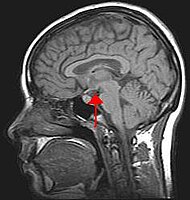
Photo from wikipedia
The neuropeptide oxytocin is produced in the paraventricular hypothalamic nucleus and the supraoptic nucleus of the hypothalamus. In addition to its extensively studied influence on social behavior and reproductive function,… Click to show full abstract
The neuropeptide oxytocin is produced in the paraventricular hypothalamic nucleus and the supraoptic nucleus of the hypothalamus. In addition to its extensively studied influence on social behavior and reproductive function, central oxytocin signaling potently reduces food intake in both humans and animal models and has potential therapeutic use for obesity treatment. In this review, we highlight rodent model research that illuminates various neural, behavioral, and signaling mechanisms through which oxytocin’s anorexigenic effects occur. The research supports a framework through which oxytocin reduces food intake via amplification of within-meal physiological satiation signals rather than by altering between-meal interoceptive hunger and satiety states. We also emphasize the distributed neural sites of action for oxytocin’s effects on food intake and review evidence supporting the notion that central oxytocin is communicated throughout the brain, at least in part, through humoral-like volume transmission. Finally, we highlight mechanisms through which oxytocin interacts with various energy balance-associated neuropeptide and endocrine systems (e.g., agouti-related peptide, melanin-concentrating hormone, leptin), as well as the behavioral mechanisms through which oxytocin inhibits food intake, including effects on nutrient-specific ingestion, meal size control, food reward-motivated responses, and competing motivations.
Journal Title: International Journal of Molecular Sciences
Year Published: 2021
Link to full text (if available)
Share on Social Media: Sign Up to like & get
recommendations!